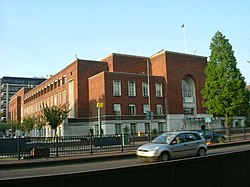Hammersmith and Fulham London Borough Council
Hammersmith and Fulham London Borough Council | |
|---|---|
| Whole council elected every four years | |
| Coat of arms or logo | |
| Logo Logo | |
| Type | |
| Type | |
| Leadership | |
Mayor of Hammersmith & Fulham | Cllr Daryl Brown, Labour since 15 May 2019 |
Leader of the Council | Cllr Stephen Cowan, Labour |
Chief executive | Kim Dero since 14 November 2017 |
| Structure | |
| Seats | 46 councillors |
 | |
Political groups | Majority Party (35)
Opposition (11)
|
| Elections | |
| First past the post | |
Last election | 3 May 2018 |
Next election | 2022 |
| Meeting place | |
 | |
| Hammersmith Town Hall | |
| Website | |
| www | |
Hammersmith and Fulham London Borough Council is the local authority for the London Borough of Hammersmith and Fulham in Greater London, England. It is a London borough council, one of 32 in the United Kingdom capital of London. Hammersmith and Fulham is divided into 16 wards, electing a total of 46 councillors.[1] The borough council provides some shared services with Kensington and Chelsea, and Westminster. The council was created by the London Government Act 1963 as the Hammersmith London Borough Council and replaced two local authorities: Hammersmith Metropolitan Borough Council and Fulham Metropolitan Borough Council. The council was renamed on 1 January 1980.
History

There have previously been a number of local authorities responsible for the Hammersmith and Fulham area. The current local authority was first elected in 1964, a year before formally coming into its powers and prior to the creation of the London Borough of Hammersmith on 1 April 1965. Hammersmith London Borough Council replaced Hammersmith Metropolitan Borough Council and Fulham Metropolitan Borough Council. Both had been created in 1900, replacing parish vestries. Fulham was an ancient parish covering broadly the same area as the current borough. Hammersmith was governed by a separate vestry from 1631 and was formally split off as a separate civil parish in 1834. They were joined for local government from 1855 to 1886 as the Fulham District of the Metropolis, governed by the Fulham District Board of Works.[2]
It was envisaged through the London Government Act 1963 that Hammersmith as a London local authority would share power with the Greater London Council. The split of powers and functions meant that the Greater London Council was responsible for "wide area" services such as fire, ambulance, flood prevention, and refuse disposal; with the local authorities responsible for "personal" services such as social care, libraries, cemeteries and refuse collection. The council was renamed on 1 January 1979. The two tier arrangement lasted until 1986 when Hammersmith and Fulham London Borough Council gained responsibility for some services that had been provided by the Greater London Council, such as waste disposal. Hammersmith and Fulham became an education authority in 1990. Since 2000 the Greater London Authority has taken some responsibility for highways and planning control from the council, but within the English local government system the council remains a "most purpose" authority in terms of the available range of powers and functions.[3]
Powers and functions
The local authority derives its powers and functions from the London Government Act 1963 and subsequent legislation. Hammersmith and Fulham has the powers and functions of a London borough council. It is a billing authority collecting Council Tax and business rates, it processes local planning applications, it is responsible for housing, waste collection and environmental health. It is a local education authority, responsible for social services, libraries and waste disposal. The council shares responsibility with the Greater London Authority for strategic policies including housing, planning and the environment.[4]
Finances
Hammersmith and Fulham London Borough Council is the billing authority for Council Tax, and collects a precepts on behalf of the Mayor's Office for Policing and Crime, the London Fire and Emergency Planning Authority the Greater London Authority and Transport for London.[5]
Elections
Since 1964 political control of the council has been held by the following parties:[6][7]
| Party in control | Years | Lab | Con | Oth |
|---|---|---|---|---|
| Labour | 2018– | 35 | 11 | 0 |
| Labour | 2014–2018 | 26 | 20 | 0 |
| Conservative | 2010–2014 | 15 | 31 | 0 |
| Conservative | 2006–2010 | 13 | 33 | 0 |
| Labour | 2002–2006 | 28 | 18 | 0 |
| Labour | 1998–2002 | 36 | 14 | 0 |
| Labour | 1994–1998 | 33 | 15 | 2 |
| Labour | 1990–1994 | 28 | 22 | 0 |
| Labour | 1986–1990 | 40 | 9 | 1 |
| No Overall Control | 1982–1986 | 25 | 23 | 2 |
| No Overall Control | 1978–1982 | 24 | 24 | 2 |
| Labour | 1974–1978 | 48 | 10 | 2 |
| Labour | 1971–1974 | 58 | 2 | 0 |
| Conservative | 1968–1971 | 6 | 54 | 0 |
| Labour | 1964–1968 | 53 | 7 | 0 |
See also
References
- ^ Councillors Archived 2013-01-18 at the Wayback Machine London Borough of Hammersmith and Fulhan
- ^ Youngs, Frederic (1979). Guide to the Local Administrative Units of England. Vol. I: Southern England. London: Royal Historical Society. ISBN 0-901050-67-9.
- ^ Leach, Steve (1998). Local Government Reorganisation: The Review and its Aftermath. Routledge. p. 107. ISBN 978-0714648590.
- ^ "Local Plan Responses – within and outside London". Mayor of London. Retrieved 9 April 2020.
- ^ "Council Tax and Business Rates Billing Authorities". Council Tax Rates. Retrieved 8 April 2020.
- ^ "Local elections: Hammersmith & Fulham". BBC News Online. Retrieved 16 October 2009.
- ^ "London Borough Council Elections 2014" (PDF). Retrieved 9 April 2020.


